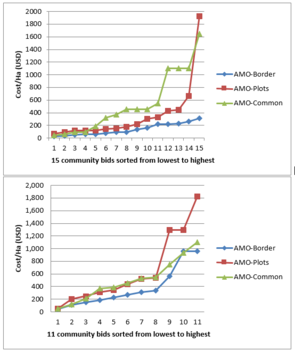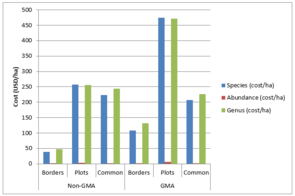Incentives for in situ conservation of CWR in Zambia
An assessment of cost effectiveness of in situ conservation options for CWR was carried out in Zambia. Warwick Wainwright (University of Edinburgh), Adam G. Drucker (Bioversity International) and Dickson Ng’uni (Zambia Agriculture Research Institute) report here about results.
Introduction
Conceptual background
Methodology
Key findings
Recommendations
Introduction

Crop Wild Relatives (CWR) are a plant group containing valuable genes for plant breeders but are threatened globally by climate change and agricultural intensification. This has led to increasing calls to increase conservation efforts, particularly in situ. However, little is known about the costs associated with in situ conservation which hampers efforts to establish conservation sites. We undertook a Competitive Tender for CWR conservation contracts with farmer communities in Zambia (Fig. 1) to determine the costs associated with in-situ conservation at sites adjacent to Game Management Areas [GMAs] (poorer communities) and sites far from Game Management Areas [non-GMAs] (less poor communities).
Conceptual background
The approach used here extends previous payments for ecosystem services (PES) work applied to the conservation of domesticated agrobiodiversity (see http://tinyurl.com/PACS-info-and-publications) to CWR.
A mixture of private and public good benefits are associated with the provisioning, regulating, cultural and supporting ecosystems services of agrobioidversity. From an economics perspective it is the pervasiveness of such public good values (i.e. positive externalities), which have non-market values associated with them, that is leading to an underinvestment in the maintenance of agrobioidversity and hence a major reason for its loss. Effectively, private good values 1 that can be easily appropriated by individual farmers are being traded-off against unvalued public good 2 ecosystem services that benefit broader society and are much more difficult to individually appropriate.
With no market incentive to conserve agricultural biodiversity in situ or on-farm, much genetic resources conservation occurs as a result of farmer socio-cultural preferences. Yet given the spatial differentiation of the relative costs (farm level) and benefits (national and global) of the maintenance of biodiversity, we increasingly risk losing these precious resources, as poor smallholder farmers not only cannot be expected to alone incur the opportunity costs of their maintenance but may collectively also not be able to do so as at level considered sufficient from a public good conservation perspective.
A solution to this dilemma may be found in the provision of incentives to farmers who conserve agricultural biodiversity on their farms and in surrounding communal lands. The importance of the design and implementation of such positive incentives for the conservation of biodiversity has been explicitly recognized, inter alia, by the Convention on Biological Diversity (Aichi Target 3).
A good understanding of the opportunity costs involved is thus fundamental to ensuring that incentives are set appropriately and will also play a key role in determining the total resources required to implement the conservation programme.
However, there is a fundamental problem to be overcome by the conservation agency (be it governmental or non-governmental) with regard to the identification of such opportunity costs. Given that such costs may vary significantly between farming households (because of different preferences for the species/varieties/breeds in question, different availability of land and labour, etc.) and locations, it is extremely difficult for the agency to know other than in very general terms what the true opportunity costs might be. By contrast, individual farmers are likely to be well aware of their true opportunity costs 3. Such differences are referred to by economists as “information asymmetries” and the existence of such differences in knowledge can result in farmers having an incentive to exaggerate their true opportunity costs in order to maximize the conservation payments they would receive. This in turn would lead to higher overall conservation costs and, given limited conservation budgets, leaving less funding available for conserving additional threatened varieties. Given that better outcomes could have been achieved if the true opportunity costs had been known by the conservation agency, such outcomes are not considered to be cost-effective.
Competitive tender schemes using auction-based mechanisms have been shown to be capable of tackling the lack of cost-effectiveness arising from the existence of information asymmetries by identifying participating farmers' actual conservation costs. This is because such competitive processes provide farmers with an incentive to reveal their true opportunity costs, as the higher the payment demanded, the lower the probability of being selected to participate in the conservation programme. Accordingly, it is argued that such tender mechanisms are able to maximize the efficiency of PES, relative to fixed price approaches (e.g. where everyone is paid the same unit amount). Although conservation tenders are increasingly being applied in PES settings, especially in developed countries, to the best of our knowledge this study is the first to apply it in a crop wild relative context.
1 Private benefits include direct use values (e.g. crop, plant and livestock products for food, clothing, shelter, medicinal and sociocultural purposes).
2 Public benefits include indirect use values (such as agroecosystem resilience; as well as maintenance of gene flow, evolutionary processes, soil and water quality, pollinators and traditional knowledge) and non-use values (e.g. option and existence values, where the former is a kind of insurance value given risk aversion and uncertainty about the future – such as that arising from climate change or new disease challenges).
3 Similarly, the conservation agency will be best-placed to be aware of the degree of threat faced by specific species, landraces or breeds, while farmers might be unaware about seemingly locally abundant genetic resources in fact being threatened at landscape, national or global scales.
Methodology

A number of focus groups were conducted with farmers at different communities to determine (i) existence and management of CWR and (ii) conservation activities and costs associated with their management.
Within the competitive tender approach context, farmer members from communities at non-GMA (less poor) and GMA areas (poor) had the opportunity to make a bid offer to enrol land in a range of Area Management Options (AMOs) which we identified as beneficial for CWR conservation (Fig. 2): AMO-Borders (conservation in field borders); AMO-Plots (conservation in crop lands) and AMO-Common (conservation in community conservation areas). Using such an approach allowed evaluation of the following:
- Estimation of in situ conservation costs associated with CWR populations across study sites.
- Appraisal of farmer opportunity cost associated with conservation at both non-GMA and GMA areas.
- Ranking of community bid offers and assessment of bid offer performance under different scenarios across the different AMOs to identify least cost conservation providers.
The project also implemented a number of walking transects in each of the AMOs to identify CWR diversity and abundance counts. This was used to measure the per-unit cost of conservation services relative to CWR populations.
Key findings
- A number of management practices which communities considered capable of reducing CWR erosion were identified. These included selective weeding in crop lands; controlled grazing practices on communal lands; maintaining field borders and early or reduced burning practices on communal lands.
- Communities made CWR conservation service contract offers based on Areas Management Options (AMOs) identified as beneficial for CWR conservation that imply total direct (i.e. excluding monitoring and administration costs) conservation costs would amount to US$ 304,000 if all the offers from the surveyed communities were to be funded, leading to a total area being conserved of 1,315 ha (equivalent to US$ 231/ha).
- We compared three different budget scenarios (low; medium and high). The budget scenarios considered conservation area; number of farmers; plots and budget as model constraints and varied with the AMOs. The total budget under the different model scenarios was US$ 23k, 46k and 69k for the low, medium and high scenarios respectively.
- Least cost conservation sites and management practices are to be found in field borders or communal lands (Fig. 3). Furthermore, not only was the conservation of CWRs considered by farmers to involve relatively higher opportunity costs in crop lands, but such lands contained the lowest levels of CWR diversity and abundance (Fig. 4).
- Median bid offers per farmer for AMO-Borders amounted to US$ 92 and $ 96 for non-GMA and GMA sites respectively. For AMO-Plots bid offers were US$ 138 and $275 for non-GMA and GMA sites respectively. This is approximately equivalent to 29 and 30 days of paid labour for AMO-Borders and 44 and 87 days for AMO-Plots (non-GMA sites and GMA sites respectively).
- Conservation costs in Non-GMA and GMA sites were cheapest for AMO-Borders costing $ 39.3 and $ 108.8 per species or $ 47.8 and $ 131.4 per genus respectively per hectare per year.


Recommendations
- Efforts should focus on AMO-Borders and AMO-Common given significantly higher species, abundance and genus counts were recorded in these areas thereby increasing the cost effectiveness of conservation services per hectare.
- Identification of areas with relatively high concentrations of CWR (abundance and diversity) is a priority for targeting locations where incentives for conservation should be implemented. The use of gap analysis to identify areas containing a Minimum Viable Population (MVP) (i.e. >5,000 individuals) where conservation would ultimately be successful from a genetic diversity perspective and entails:
- Identification of priority CWR taxa based on potential usefulness of plant species in crop improvement strategies through gene transfer.
- Analysis of CWR population records to identify areas of high CWR diversity and abundance.
- Assessment of areas with elevated CWR populations on-farm whereby good agricultural practices are likely to have contributed to CWR abundance
- Final identification of 5 ecogeographically distinct zones for each taxon and a minimum of 3 farmers per zone to undertake conservation services (in line with budget costs). Note many CWR will overlap different taxa so this will reduce conservation costs.
- Implementation of a tender-based CWR conservation programme would require that a monitoring programme (likely to require both conventional and participatory monitoring methods) be implemented in order to assess both (i) compliance and (ii) the actual impact (relative to an established baseline) on CWR diversity and species under the respective AMOs.
Acknowledgements
We would like to thank Graybill Munkombwe and Masiye Tembo for their assistance during the fieldwork visits to community groups. We also thank Ehsan Dulloo and Nigel Maxted for their assistance in designing the survey and sampling strategies. Finally, we thank the community groups for their cooperation with the focus groups and workshops in Eastern and Muchinga province.